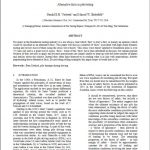Post Driveability Study for Caesar’s Rhine Bridge 55 B.C.
Titel |
Post Driveability Study for Caesar’s Rhine Bridge 55 B.C. |
 SW2022 – Post Driveability Study for Caesar's Rhine Bridge 55 B.C. |
Author(s) |
Middendorp, P; Verbeek, G; Bielefeld, M |
|
Year |
2022 |
|
Language |
English |
|
Where |
11th Int Stress Wave Conference, Rotterdam, The Netherlands |
|
Cite as |
Middendorp, P, Verbeek, G, & Bielefeld, M. (2022, September 20). Post Driveability Study for Caesar’s Rhine Bridge 55 B.C. 11th International Conference on Stress Wave Theory and Design and Testing Methods for Deep Foundations (SW2022), Rotterdam, The Netherlands. https://doi.org/10.5281/zenodo.7151569 |
ABSTRACT:
As the story goes, in the early summer of 55 BC the Roman general Julius Caesar had a 400 m long bridge built over the Rhine within just 10 days and then demolished again after a few days. According to Caesar, the bridge was built to be able to carry out a punitive expedition against the Germans on the right bank of the Rhine. The bridge was undoubtedly a beam or yoke bridge. The distances between the yokes were at most 12 m, so that a total of 30 – 35 yokes were required. The piles consisted of tree trunks pointed at the bottom, most likely without the iron pile shoes that were otherwise common among the Romans. The piles were driven into the riverbed with specially designed pile drivers, which means that there must have been experience with taking pile driving conditions into account and understanding of those conditions at the job site. Nowadays a pile driveability study would have been part of the bridge design process. The authors took up the challenge to perform a post driveability study for this bridge based on the limited data available and the results are presented in this paper. The predictions were performed with the wave
equation program AllWave-PDP.
DOWNLOAD:
You can download the entire article here after entering your name and e-mail address:




